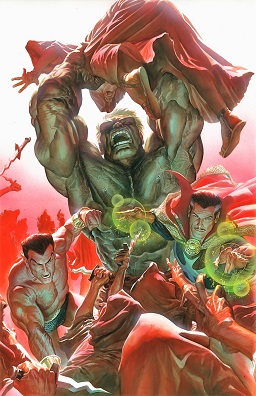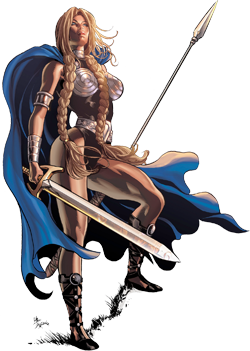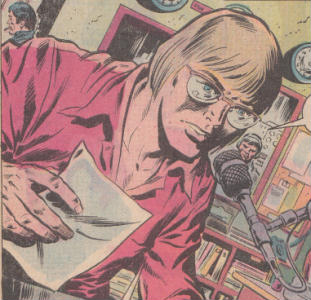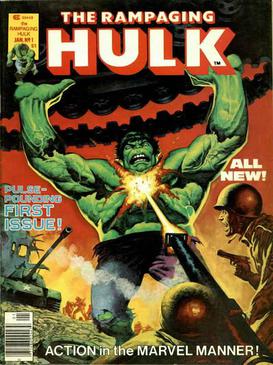Related Research Articles

Dr. Stephen Vincent Strange is a character appearing in American comic books published by Marvel Comics. Created by Steve Ditko, the character first appeared in Strange Tales #110. Doctor Strange serves as the Sorcerer Supreme, the primary protector of Earth against magical and mystical threats. Strange was introduced during the Silver Age of Comic Books in an attempt to bring a different kind of character and themes of mysticism to Marvel Comics.

Howard the Duck is a fictional character appearing in American comic books published by Marvel Comics. The character was created by writer Steve Gerber and artist Val Mayerik. Howard the Duck first appeared in Adventure into Fear #19 and several subsequent series have chronicled the misadventures of the ill-tempered anthropomorphic animal trapped on a human-dominated Earth. Echoing this, the most common tagline of his comics reads 'Trapped In a World He Never Made!'.
Sal Buscema is an American comics artist, primarily for Marvel Comics, where he enjoyed a ten-year run as artist of The Incredible Hulk and an eight-year run as artist of The Spectacular Spider-Man. He is the younger brother of comics artist John Buscema.

The Defenders are a set of superhero groups with rotating membership appearing in American comic books published by Marvel Comics. They are usually presented as a "non-team" of individualistic "outsiders" who, in their prior adventures, are known for following their own agendas. The team often battle mystic and supernatural threats.

The Abomination is a character appearing in American comic books published by Marvel Comics. Created by writer Stan Lee and artist Gil Kane, the character first appeared in Tales to Astonish #90. He is one of the main enemies of the superhero Hulk, and possesses powers similar to his after also being exposed to gamma rays.

Stephen Ross Gerber was an American comic book writer and creator of the satiric Marvel Comics character Howard the Duck. Other works include Man-Thing, Omega the Unknown,Marvel Spotlight: "Son of Satan", The Defenders,Marvel Presents: "Guardians of the Galaxy", Daredevil and Foolkiller. Gerber often included lengthy text pages in the midst of comic book stories, such as in his graphic novel, Stewart the Rat. Gerber was posthumously inducted into the Will Eisner Comic Book Hall of Fame in 2010.

The Man-Thing is a fictional character appearing in American comic books published by Marvel Comics. Created by writers Stan Lee, Roy Thomas, and Gerry Conway and artist Gray Morrow, the character first appeared in Savage Tales #1, and went on to be featured in various titles and in his own series, including Adventure into Fear. Steve Gerber's 39-issue run on the series is considered to be a cult classic.

Valkyrie is a superheroine appearing in American comic books published by Marvel Comics. Created by Roy Thomas and John Buscema, the character first appeared in The Avengers #83. She is based on the Norse mythological figure Brynhildr. Valkyrie became a mainstay of the superhero team known as the Defenders and a close ally and one-time love interest of the god Thor.

Gorilla-Man is an alias used by three different fictional superheroes appearing in American comic books published by Marvel Comics, beginning in 1954 with the character of Kenneth Hale, and continuing with Arthur Nagan, who also first appeared in 1954, and Franz Radzik, who first appeared in 1962.

Jennifer Kale is a character appearing in American comic books published by Marvel Comics. Created by writer Steve Gerber and artist Rich Buckler, the character first appeared in Adventure into Fear #11. Jennifer Kale is a sorceress who is part of the Cult of Zhered-Na. She has also been a member of the Legion of Night and the Midnight Sons at various points in her history.

Doctor Bong is a fictional supervillain appearing in American comic books published by Marvel Comics. The character possesses an advanced knowledge of genetic engineering, and his bell-shaped helmet can be struck to create a number of effects. Intended as a parody of Doctor Moreau, he is an archenemy of Howard the Duck.

Ruby Thursday is a fictional character appearing in American comic books published by Marvel Comics. She is usually depicted as a member of the Headmen. She is named for the Rolling Stones song, "Ruby Tuesday".

Orrgo is a fictional character appearing in American comic books published by Marvel Comics.

Chondu the Mystic, sometimes known as Chondu the Magician, is a fictional character appearing in American comic books published by Marvel Comics.

World of Fantasy was a science fiction/fantasy comic book anthology series published by Marvel Comics' 1950s predecessor company, Atlas Comics. Lasting from 1956 to 1959, it included the work of several notable comics artists, including industry legends Jack Kirby, Steve Ditko, and Bill Everett.

Richard Rory is a fictional character appearing in American comic books published by Marvel Comics. He initially was a sort of author surrogate or alter ego for writer Steve Gerber, though Gerber is also shown to exist in the Marvel Universe. He was introduced in Man-Thing Volume 1, #2, a bit of a loner who rather easily befriended the nearly mindless monster. When in rural areas, he was frequently belittled for having a college education and a rather left-wing perspective. Later, under the pen of David Anthony Kraft, he became friends with She-Hulk, with slight romantic overtones that went nowhere. The character is named after Richard Cory, a nearly opposite character whose song was playing on the radio when Gerber created the character.

The Rampaging Hulk is a comic book series published by Marvel Comics. The first volume was a black and white magazine published by Curtis Magazines from 1977–1978. With issue #10, it changed its format to color and its title to The Hulk!, and ran another 17 issues before it was canceled in 1981. It was a rare attempt by Marvel to mix their superhero characters with the "mature readers" black-and-white magazine format.

The Incredible Hulk is an ongoing comic book series featuring the Marvel Comics superhero the Hulk and his alter ego Dr. Bruce Banner. First published in May 1962, the series ran for six issues before it was cancelled in March 1963, and the Hulk character began appearing in Tales to Astonish. With issue #102, Tales to Astonish was renamed to The Incredible Hulk in April 1968, becoming its second volume. The series continued to run until issue #474 in March 1999 when it was replaced with the series Hulk which ran until February 2000 and was retitled to The Incredible Hulk's third volume, running until March 2007 when it became The Incredible Hercules with a new title character. The Incredible Hulk returned in September 2009 beginning at issue #600, which became The Incredible Hulks in November 2010 and focused on the Hulk and the modern incarnation of his expanded family. The series returned to The Incredible Hulk in December 2011 and ran until January 2013, when it was replaced with The Indestructible Hulk as part of Marvel's Marvel NOW! relaunch.